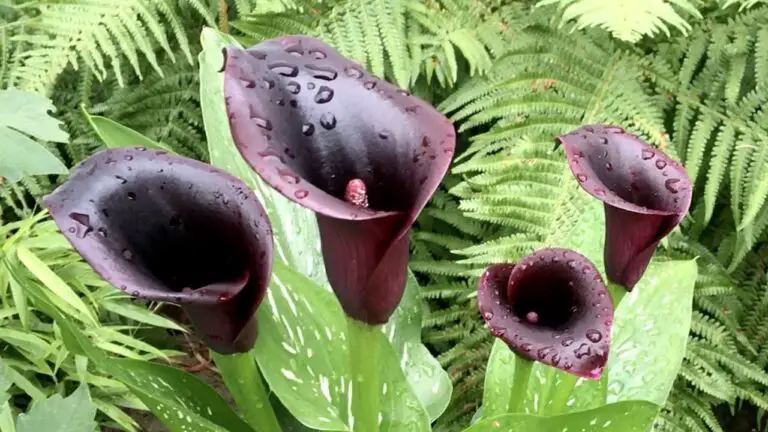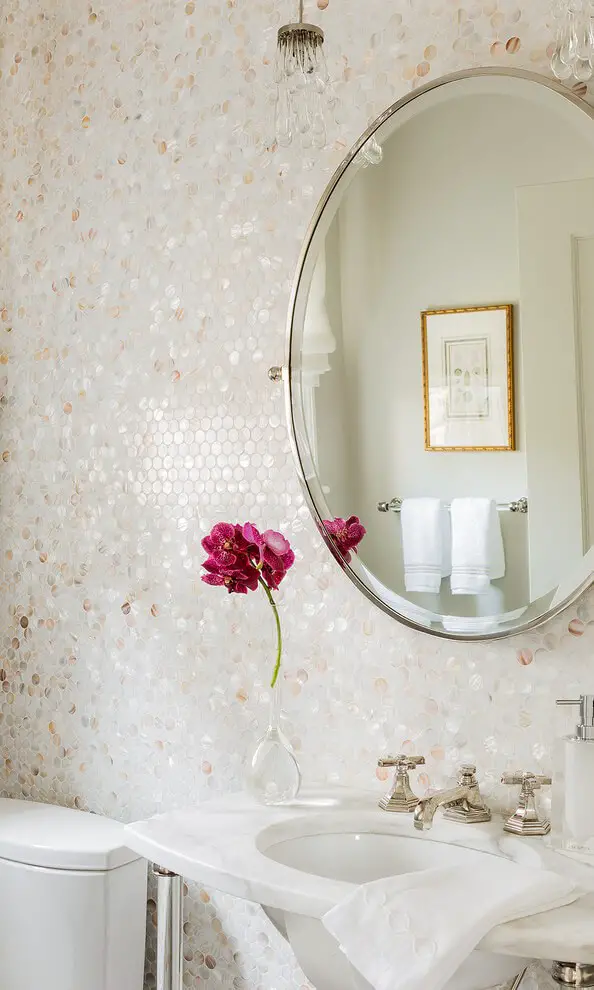14 Bedroom Plants Will Help You Get A Better Nights Sleep
Do you struggle to get a good night’s sleep? The quest for restful slumber is a common challenge many face. But what if we told you that introducing certain plants into your bedroom could be a natural and effective solution to enhance your sleep quality? Believe it or not, recent studies have started to back up the idea that certain plants can indeed play a significant role in helping you achieve better sleep.
These aren’t just any ordinary houseplants – they’re carefully selected for their unique benefits that can improve air quality, reduce stress, and create a more soothing environment conducive to sleep. In this article, we’ll delve into the science behind how bedroom plants can improve your sleep quality, from reducing airborne mold levels to promoting relaxation through scent.
We’ll also explore the best plants to keep in your bedroom for better sleep, along with some essential care tips and guidelines to ensure you’re getting the most out of these natural sleep aids. Some of the plants we’ll be discussing include lavender, which can help promote relaxation and reduce anxiety; jasmine, which has been shown to improve sleep quality; and snake plant, which is great at producing oxygen during nighttime.
We’ll also cover other plants like aloe vera, spider plant, English ivy, rubber plants, golden pothos, bamboo palm, gardenia, valerian, and chamomile – each with its own unique benefits for improving sleep.
The Science Behind Plants and Sleep
Improving Air Quality for Better Sleep
While having bedroom plants can elevate the aesthetic appeal of your sleeping space, it also has a profound impact on the air quality within that space. Plants act as natural air purifiers, absorbing carbon dioxide and releasing oxygen, thereby enriching the atmosphere with fresh, clean air. This beneficial exchange creates an environment conducive to relaxation and rejuvenation during sleep, allowing your body to breathe easily and thrive overnight.
Photosynthesis at Night
While some plants wind down their activities when the sun sets, others continue to thrive through the night, producing oxygen via photosynthesis. The Snake Plant and Aloe Vera are two examples that remain busy even in darkness. This nocturnal productivity has a practical benefit – maintaining a consistent supply of fresh air in enclosed spaces where circulation may be limited.
As you sleep, these plants quietly work to purify the air around you, ensuring a steady flow of oxygen throughout the night.
The Power of Plant Scents
The calming effects of certain plants don’t stop at air purification – they also release soothing scents that can quiet the mind and body, making it easier to drift off to sleep. Take lavender, for instance, whose renowned relaxing aroma has been known to ease individuals into a peaceful slumber. When inhaled, these natural fragrances can actually lower stress and anxiety levels, paving the way for a restful night’s sleep.
By stimulating our senses, these plant scents send a signal to our brain that it’s time to wind down and get some much-needed rest.
The benefits of certain plants don’t stop there. Jasmine, for example, has been shown to reduce anxiety levels and improve the overall quality of one’s sleep. By incorporating plants into your bedroom, you’re not just decorating – you’re investing in a natural remedy that can have a significant impact on the quality of your sleep.
And with their simplicity and effectiveness, it’s no wonder they’ve become an ideal addition to any bedroom looking to enhance its sleep environment.
Lavender
Lavender’s charm lies in its harmonious blend of visual appeal and soothing essence. This low-maintenance plant thrives in sunny environments, growing up to 2 feet tall and boasting small, compact bushes. The real showstopper is the lavender flower, boasting a vibrant purple hue and delicate structure that’s as captivating as it is fragrant. The plant’s leaves, with their subtle green or silvery tones, add an extra layer of visual interest.
Not only is lavender a gardener’s delight, but its aesthetic and health benefits also make it a popular choice for home use.
How Its Scent Promotes Relaxation and Sleep
Lavender’s calming effects don’t stop at just a pleasant aroma – its fragrance has been scientifically proven to soothe both the mind and body. When breathed in, lavender’s scent can significantly reduce feelings of stress and anxiety, creating an atmosphere of serenity and tranquility. This peaceful ambiance is essential for setting the stage for a restful night’s sleep. By mitigating stress levels, lavender makes it easier to drift off to sleep and stay asleep throughout the night.
The science behind this phenomenon is rooted in lavender’s impact on the nervous system, which promotes relaxation and enhances overall sleep quality. It’s no wonder that lavender is often incorporated into sleep-enhancing products, such as essential oils, sachets, and pillow sprays. According to studies, lavender’s scent can: reduce stress and anxiety, making it easier to fall asleep; promote relaxation, lowering heart rate and blood pressure; and improve sleep quality.
By incorporating lavender into your bedroom – whether through a potted plant, dried bouquets, or scented products – you can create a sleep-conducive environment that will have you sleeping better in no time.
Jasmine
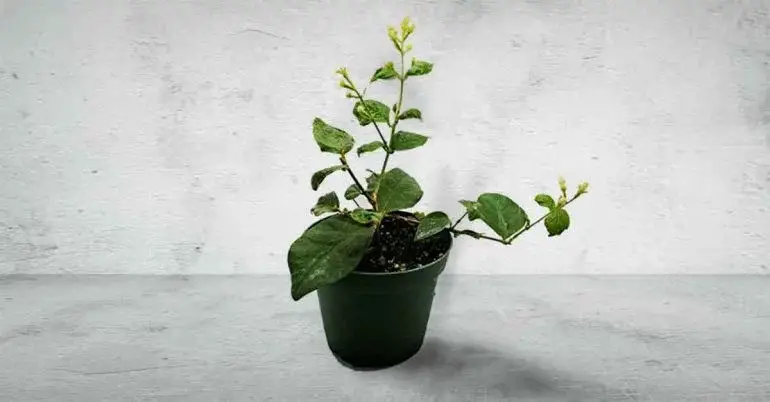
Jasmine is an enchanting plant that charms with its dual allure of beauty and fragrance. Its delicate white or yellow flowers are not only visually stunning, adding a touch of sophistication to any space, but also release a sweet and soothing scent that can transport you to a state of serenity. This calming aroma is particularly potent in the bedroom, making Jasmine an ideal companion for a restful night’s sleep.
The plant’s intricate blooms and glossy green leaves can transform your bedroom into a peaceful oasis, inviting relaxation and tranquility.
Its Effect on Reducing Anxiety and Improving Sleep Quality
The soothing aroma of jasmine has been linked to a range of benefits, including reduced anxiety levels and improved sleep quality. By inhaling the gentle fragrance, individuals can calm their minds and bodies, easing stress and preparing themselves for a restful night’s sleep. This calming effect is particularly beneficial for those who struggle to wind down at the end of the day, as it fosters a relaxed state that can lead to quicker sleep onset and deeper, more restful slumber.
In fact, jasmine’s aromatic properties have been shown to promote relaxation, leading to uninterrupted sleep and a rejuvenated body.
The following table highlights how jasmine’s calming effects can positively impact sleep:
BenefitHow Jasmine HelpsImpact on Sleep
Anxiety ReductionSoothing fragrance reduces stressFacilitates easier sleep onset
Sleep QualityPromotes relaxationLeads to deeper, uninterrupted sleep
The visual beauty of jasmine is not its only appeal – its natural calming effects make it a valuable addition to any bedroom aiming to enhance sleep quality.
By incorporating jasmine into your bedding or decor, you can create a more relaxing and sleep-conducive environment that promotes better rest and rejuvenation.
Peace Lily
The Peace Lily, scientifically known as Spathiphyllum, boasts a unique combination of lush green leaves and striking white flowers that evoke a sense of serenity. Beyond its visual appeal, this plant is renowned for its remarkable ability to boost humidity levels in its surroundings. Through the process of transpiration, the Peace Lily’s leaves release moisture into the air, making it a natural humidifier.
This feature can prove particularly beneficial in dry climates or during winter months when indoor air tends to be drier. By incorporating this plant into your bedroom, you can create a cozy and comfortable environment that fosters relaxation and rejuvenation.
How It Can Alleviate Dry Noses and Throats to Improve Sleep
Maintaining an optimal humidity level is vital for a restful night’s sleep. Dry air can cause discomfort in the respiratory system, leading to irritated noses and throats that disrupt sleep patterns. The Peace Lily’s unique ability to increase humidity levels can alleviate these symptoms by ensuring the air you breathe while asleep is moist and comfortable. This can result in a more peaceful sleeping environment, promoting uninterrupted and restful sleep.
The benefits of incorporating a Peace Lily into your bedroom are multifaceted. Not only will it enhance the aesthetic appeal of your space, but it will also take a natural step toward creating a healthier and more conducive sleeping environment. Its low-maintenance nature and numerous health benefits make the Peace Lily an ideal choice for anyone seeking to improve their sleep quality in a natural way.
Snake Plant

The Snake Plant, or Sansevieria, boasts an unmistakable presence with its striking, upright leaves that can add a dramatic flair to any bedroom. Beyond its visually appealing characteristics, this versatile plant is renowned for its exceptional air-purifying abilities. The Snake Plant has been proven to be highly effective in removing common indoor air pollutants such as benzene, formaldehyde, trichloroethylene, xylene, and toluene.
Its unique ability to absorb carbon dioxide and release oxygen, particularly during the night, makes it an excellent choice for enhancing indoor air quality and promoting a restful sleep environment. With its minimal maintenance requirements, the Snake Plant is ideal for busy individuals who want to reap the benefits of having a low-maintenance yet highly effective plant in their home.
Its Role in Oxygen Production During Nighttime
Unlike many plants, the Snake Plant stands out for its ability to perform photosynthesis at night, a process known as Crassulacean Acid Metabolism (CAM). This unique characteristic allows it to continuously absorb carbon dioxide and release oxygen even after the sun sets. As a result, it maintains a steady supply of fresh air throughout the night, creating an optimal sleeping environment. By producing increased oxygen levels, this plant can significantly enhance overall sleep quality.
The benefits of its nighttime oxygen production can be summarized as follows: continued oxygen production at night, enhanced air quality for better sleep, absorption of carbon dioxide and other pollutants, creation of a healthier sleeping environment, and low maintenance requirements that allow it to thrive with minimal water and light.
By incorporating a Snake Plant into your bedroom, you’re not only adding a decorative element but also enriching the space with cleaner air and a natural source of oxygen at night. This easy-to-care-for plant is an intelligent choice for anyone seeking to improve their sleep quality by creating a healthier and more natural sleeping environment.
Chinese Evergreen
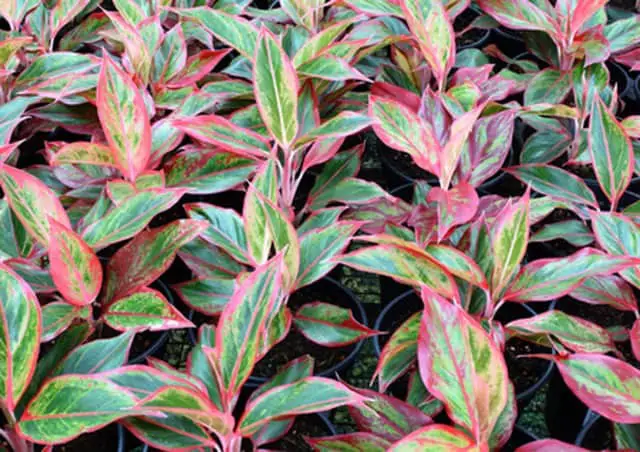
The Chinese Evergreen, scientifically known as Aglaonema, is a highly sought-after indoor plant renowned for its striking and durable foliage. The leaves showcase an array of patterns, ranging from deep green with silver accents to vibrant red or pink hues, injecting a burst of color into any room.
Beyond its captivating visual appeal, the Chinese Evergreen also boasts exceptional air-purifying abilities, effectively neutralizing common indoor pollutants such as benzene and formaldehyde, thereby creating a cleaner and healthier environment. This remarkable plant’s dual capabilities of enhancing aesthetics while purifying the air make it a top choice for both residential and commercial spaces.
Care Tips and Suitability for Indoor Environments
The Chinese Evergreen’s adaptability to low-light conditions sets it apart from other plants, making it an excellent choice for rooms with limited natural light. Its straightforward care routine is another major draw, requiring minimal maintenance. To keep your plant happy, use well-draining soil and only water when the top inch of soil feels dry to the touch. Be mindful of overwatering, as this can lead to root rot.
The Chinese Evergreen thrives in warm environments and should be protected from drafts and sudden temperature changes. While it excels in low-light conditions, providing indirect, moderate light can encourage more vibrant leaf colors and patterns. Humidity is appreciated but not necessary for survival, making it well-suited to the typical indoor environment. A light feeding with a balanced fertilizer during the growing season will support its health and vitality.
The plant’s adaptability is highlighted in the table below. The Chinese Evergreen brings a touch of exotic beauty to your space while also playing a role in creating a healthier living environment. Its ease of care, low-light tolerance, and air-purifying properties make it an excellent choice for enhancing indoor aesthetics and air quality. By incorporating this plant into your indoor collection, you’ll not only enjoy its unique charm but also benefit from its practical benefits.
Aloe Vera
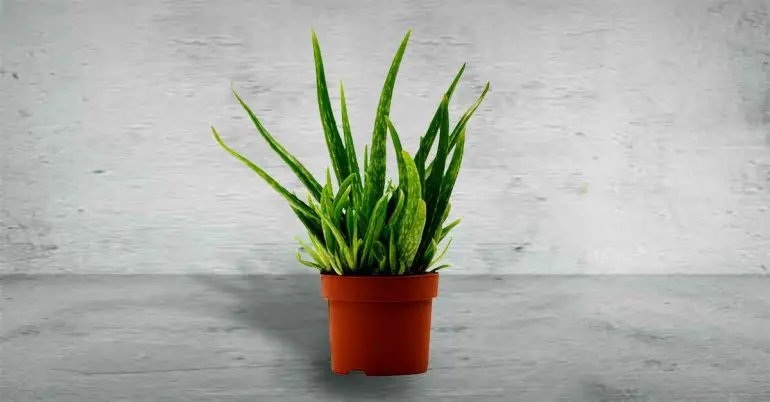
Aloe Vera is a remarkable succulent plant renowned for its extraordinary ability to thrive in dry conditions, thanks to its thick, fleshy leaves that store water. Its versatility extends beyond skin care, as it’s also celebrated for its impressive air-purifying qualities. This unique feature sets it apart from many other plants, making it an excellent choice for a bedroom companion.
In fact, Aloe Vera has the ability to improve indoor air quality by absorbing carbon dioxide and releasing oxygen, especially at night. This natural process enhances air quality during sleep, providing a healthier and more rejuvenating sleeping environment. The plant’s characteristics, including its low maintenance needs and ideal suitability for indoor environments, only add to its appeal.
Benefits for Sleep Through Oxygen Production at Night
Incorporating Aloe Vera into your bedtime routine can have a profound impact on the quality of your sleep. This versatile plant has several natural benefits that make it an ideal addition to any bedroom. One of its most notable advantages is its ability to purify the air, absorbing carbon dioxide and releasing oxygen at night. This increase in oxygen levels can lead to improved breathing, which is essential for a restful night’s sleep.
Additionally, Aloe Vera’s low maintenance requirements mean you don’t have to worry about complicated care routines, allowing you to focus on getting a good night’s sleep. By placing an Aloe Vera plant in your bedroom, you’re creating a stress-free and rejuvenating environment that can help you achieve a deeper and more restful sleep.
Spider Plant
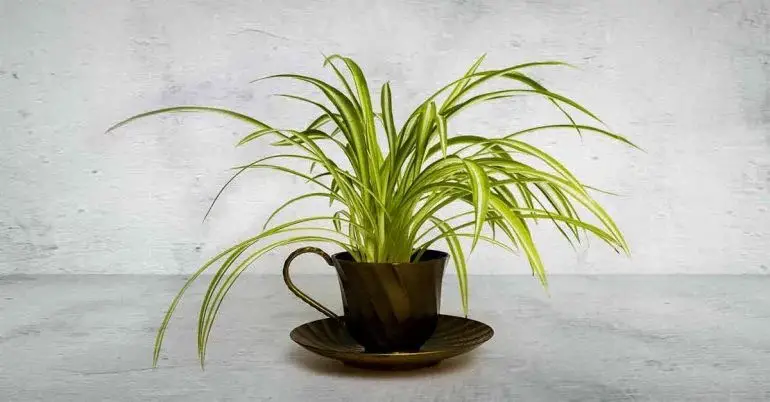
The Spider Plant, scientifically classified as Chlorophytum comosum, stands out for its vibrant green foliage and fascinating growth pattern. The plant’s ability to produce small, dangling plantlets that resemble spiders on a web adds a unique visual element to any room.
Beyond its aesthetic appeal, the Spider Plant is a natural air purifier, renowned for its capacity to absorb pollutants like carbon monoxide and xylene.
This remarkable trait makes it an ideal choice for improving indoor air quality, particularly in bedrooms where a clean environment can greatly impact breathing conditions during sleep. By harnessing the plant’s ability to remove impurities from the air, you can create a healthier sleeping space that fosters better overall well-being.
In terms of its growth pattern, the Spider Plant produces small plantlets that dangle from the mother plant, creating an visually appealing display.
Additionally, it is capable of absorbing pollutants and enhancing oxygen levels, further contributing to a cleaner environment.
Ease of Care and Suitability for Bedroom Environments
The Spider Plant’s exceptional adaptability is what sets it apart from other plants. It can thrive in a wide range of conditions, tolerating moderate light and occasional watering with ease. This low-maintenance quality makes it an ideal choice for bedroom environments where lighting and humidity may vary. Moreover, the plant’s non-toxic nature ensures that it’s safe for families with pets and children, eliminating any worry or concern.
The table below highlights the Spider Plant’s unique characteristics: AspectCare RequirementBedroom SuitabilityLightPrefers moderate, indirect lightAdaptable to most bedroom settingsWateringOccasional, allowing soil to dry between wateringsLow maintenanceSafetyNon-toxic to pets and childrenIdeal for family homes By incorporating a Spider Plant into your bedroom, you’re not only adding a touch of natural beauty but also contributing to a cleaner, healthier space.
Its ability to purify the air and its ease of care make it an excellent choice for anyone looking to enhance their sleep environment naturally.
English Ivy

English Ivy, scientifically known as Hedera helix, is celebrated for its exceptional air purification qualities. This evergreen vine not only boasts a lush, trailing foliage that adds aesthetic appeal to any space, but also possesses the remarkable ability to significantly enhance indoor air quality. By absorbing toxins such as benzene, formaldehyde, xylene, and toluene from the air, English Ivy proves an excellent natural purifier for your home environment.
Furthermore, this plant is astonishingly easy to cultivate, flourishing in a range of conditions from low to bright light, making it perfectly suitable for various areas of your home, including the bedroom. As a result, it’s no wonder that English Ivy has become a popular choice among indoor gardeners seeking to create a healthier and more welcoming living space.
Its Potential in Reducing Airborne Mold Levels
English Ivy stands out for its impressive ability to minimize airborne mold levels, creating a healthier living space. This remarkable feature has been particularly beneficial for individuals sensitive to mold or experiencing respiratory issues, as it allows them to simply and effectively mitigate these concerns by placing the plant in their bedroom or other areas of the home. The resulting cleaner air not only enhances sleep quality but also contributes to overall health.
In fact, English Ivy’s impact on reducing airborne mold levels can be summarized as follows: it decreases airborne mold particles, improving respiratory health; its presence contributes to a healthier environment by enhancing cleaner air, and ultimately improves sleep quality and overall well-being.
Furthermore, adding English Ivy to your home not only brings a touch of green elegance but also actively works to purify the air, making your sleeping environment more conducive to rest and rejuvenation. Its ease of care, coupled with its powerful air-cleaning and mold-reducing capabilities, makes English Ivy an excellent choice for anyone looking to naturally enhance their indoor air quality.
Rubber Plants

With their striking appearance and impressive size, Rubber Plants (Ficus elastica) are an increasingly popular choice for indoor spaces. Their glossy, dark green leaves can grow quite large, making a bold statement in any room. But beyond their visual appeal, Rubber Plants have another notable feature – their ability to purify the air.
They’re highly efficient at filtering out airborne toxins such as formaldehyde, benzene, and trichloroethylene, leaving the indoor environment cleaner and healthier. This combination of aesthetic appeal and environmental benefits makes the Rubber Plant a sought-after addition for both home and office spaces.
Care Tips and Suitability for Indoor Environments
Indoor enthusiasts can easily maintain a thriving Rubber Plant, thanks to its adaptable nature. These plants excel in bright, indirect light, but can also thrive in lower-light conditions, making them suitable for various areas of the home or office. Well-drained soil is essential, and watering only when the top inch of soil feels dry helps prevent overwatering and root rot.
While high humidity is beneficial, it’s not a necessity, allowing Rubber Plants to flourish in typical indoor environments. To keep their leaves looking their best, regular cleaning with a damp cloth can help maintain their glossy appearance and maximize air-purifying capabilities. Occasional pruning will encourage bushy growth and prevent the plant from becoming leggy. During the growing season, a balanced fertilizer can promote healthy development and boost growth.
The following care summary provides a concise overview of Rubber Plant requirements and suitability for indoor spaces:AspectCare RequirementIndoor SuitabilityLightPrefers bright, indirect lightAdaptable to various indoor settingsWateringWater when top inch of soil is dryEasy to maintain with minimal wateringHumidityTolerates average indoor humidityVersatile for most homes and officesIncorporating a Rubber Plant into your indoor space not only adds a touch of sophistication with its large, showy leaves but also enhances air quality, making it an invaluable addition to any home or office.
With straightforward care requirements and numerous benefits to indoor environments, Rubber Plants are an excellent choice for those looking to make a statement in their indoor gardening endeavors.
Golden Pothos

Golden Pothos, also known as Epipremnum aureum, is a stunning plant that stands out for its impressive air-purifying capabilities. Its vibrant, variegated heart-shaped leaves are not only a feast for the eyes but also play a crucial role in removing toxins from indoor spaces. The plant’s ability to effectively eliminate formaldehyde, xylene, and benzene makes it an excellent choice for those looking to maintain a healthier living environment.
But what sets Golden Pothos apart is its unique combination of air purification and aesthetic appeal. Its beautiful leaves add a pop of color and life to any room, making it a popular choice for home decor enthusiasts. Whether you’re seeking to enhance the ambiance of your space or simply want a low-maintenance plant that can help purify the air, Golden Pothos is an excellent option.
Low Maintenance, Making It Ideal for Bedroom Settings
The Golden Pothos is renowned for its extraordinary tolerance for neglect, making it an ideal addition to any bedroom. Its remarkable ability to thrive in various light conditions – from dimly lit to bright indirect light – allows it to effortlessly adapt to the unique conditions of your personal sanctuary. Watering this plant is a breeze, as it only requires attention when the soil has fully dried out.
This stress-free care routine makes the Golden Pothos an excellent choice for busy individuals or those new to plant parenthood.
What sets the Golden Pothos apart from other plants is its remarkable ability to purify the air while requiring minimal upkeep. Its potency in removing toxins and pollutants from the air creates a healthier sleep environment, further solidifying its position as an excellent bedroom companion.
By incorporating this low-maintenance yet effective air-purifying plant into your bedroom, you’ll not only enhance its aesthetic appeal but also contribute to a tranquil and rejuvenating atmosphere.
Bamboo Palm

The Bamboo Palm (Chamaedorea seifrizii) is a sought-after indoor plant that effortlessly brings the essence of the tropics into any room. Its slender green stalks and luxuriant foliage, reminiscent of bamboo, make it a visually appealing addition to any space. However, its benefits extend far beyond its aesthetic appeal. This palm is renowned for its air-purifying qualities, capable of removing common indoor toxins such as formaldehyde, benzene, and carbon monoxide from the air.
As a result, it’s an excellent choice for enhancing indoor air quality in both homes and offices. The Bamboo Palm’s ability to thrive in indoor conditions while simultaneously improving the environment makes it a favored plant among those seeking to create a healthier living or working space.
Care Tips and Suitability for Indoor Environments
Incorporating a Bamboo Palm into your home or office is a great way to bring a touch of tropical elegance indoors. One of its most notable features is its adaptability, making it suitable for a wide range of environments. This palm thrives in well-drained soil and consistent moisture, with high humidity levels promoting lush growth. However, it can also tolerate average home conditions, providing flexibility in placement.
Regular watering and occasional fertilizing during the growing season keep your Bamboo Palm healthy and thriving. It’s essential to avoid overwatering, as this can lead to root rot. Providing ample space for its fronds to spread ensures the plant develops fully, showcasing its natural beauty and air-purifying capabilities.
The Bamboo Palm is an excellent choice for those seeking a low-maintenance yet beneficial addition to their indoor space, offering improved air quality and a touch of tropical charm.
Gardenia
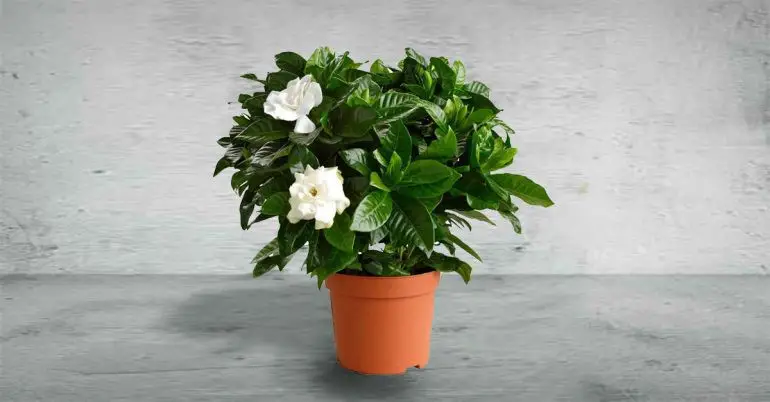
Gardenia, renowned for its stunning white flowers and alluring fragrance, embodies the essence of purity and sweetness. The captivating aroma not only delights the senses but also has a profound impact on one’s mood and emotional state, fostering a sense of calmness and relaxation. Placing a Gardenia plant in your bedroom can magically transform the space into a serene sanctuary, where the stresses of the day dissipate as you inhale the soothing scent.
Furthermore, this plant’s fragrance is often linked to relaxation and has been suggested to aid in improving sleep quality by creating a peaceful atmosphere conducive to rest. The lush white blooms add an air of elegance to room decor, making Gardenia a coveted addition to any home.
Considerations for Care, as It Can Be More Demanding Than Other Plants
While Gardenias do require more attention than some other indoor plants, the rewards are well worth the effort. To thrive, they need bright, indirect light that mimics their natural tropical habitat, as well as high humidity to keep their leaves and flowers healthy. In terms of soil, they prefer well-drained, acidic conditions, and regular watering is essential – but be sure not to overwater, as this can lead to root issues and prevent blooming.
Maintaining a consistent temperature and avoiding drafts is also crucial for their overall health. By meeting these specific care requirements, you can enjoy the many benefits of having a Gardenia in your bedroom, including its beautiful blooms and intoxicating fragrance. The table below outlines key care considerations and how they impact the plant’s growth and health.
The rewards of caring for a Gardenia are immense – not just in terms of its stunning flowers, but also the sense of tranquility and elegance it brings to your bedroom. By putting in a little extra effort to meet its unique needs, you can ensure that your Gardenia flourishes, filling your sleeping space with its sweet scent and stunning beauty.
Valerian
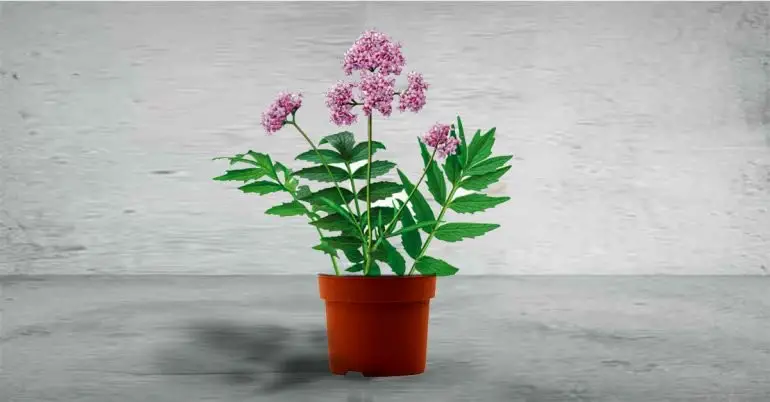
Valerian, an herb renowned for its sweet-scented pink or white flowers, has been a staple of traditional medicine for centuries. Its historical significance lies in its ability to promote relaxation, alleviate anxiety, and induce a restful night’s sleep. The roots of Valerian are particularly prized for their potent properties, which can calm the nervous system and soothe the mind.
From ancient cultures to modern times, Valerian has been a trusted natural remedy for stress relief and sleep promotion. Its long history of use is well-documented, with records showing people turning to it as a gentle aid to ease their worries and drift off into a peaceful slumber.
How Its Scent Can Help You Fall Asleep Faster
Valerian’s roots are renowned for their calming properties, which can accelerate the transition to sleep. By soothing the mind, this natural sedative enables individuals to release the day’s tensions, promoting a state conducive to a restful night’s sleep. The mere presence of Valerian in the bedroom, whether through dried roots or essential oils, can significantly contribute to creating a tranquil atmosphere that fosters quicker sleep onset.
The benefits of Valerian on sleep quality are evident: its calming scent reduces the time it takes to fall asleep and enhances the depth and quality of restful sleep. By incorporating Valerian into your bedtime routine, whether as a potted plant, dried roots, or aromatherapy, you can enjoy a gentle, natural way to improve your sleep. With its historical reputation as a sleep aid and its calming scent, Valerian is an excellent choice for anyone seeking to relax and rejuvenate during the night.
Chamomile: A Tranquil Addition to Your Bedroom
Known for Its Calming Tea, the Plant Itself Can Have a Soothing Presence
Chamomile is renowned for its calming properties when infused into tea, a tradition that embodies its tranquil essence. This herbaceous plant, boasting delicate white blooms and an enchanting, apple-like fragrance, extends its serene qualities beyond the teacup. Having Chamomile in your bedroom is not merely about visual appeal; it’s about introducing a slice of serenity into your personal space.
The gentle aroma of Chamomile flowers can soothe the mind, fostering a peaceful ambiance that encourages relaxation and prepares you for slumber. Its multifaceted benefits include promoting tranquility, adding beauty and harmony to room settings, and creating an atmosphere conducive to restful sleep.
Care Tips and How Its Aroma Can Improve Sleep
Caring for a chamomile plant is a straightforward process that makes it an excellent option for those new to indoor gardening. With minimal fuss, this lovely herb thrives in well-drained soil and partial sunlight, making it suitable for bedrooms with natural light. Consistent watering is key, allowing the soil to dry slightly between waterings. This low-maintenance routine ensures busy schedules won’t get in the way of your plant’s health.
Beyond its ease of care, chamomile’s sweet aroma has a profound impact on sleep quality. As you inhale its calming scent, it subtly calms the nervous system, reducing feelings of anxiety and paving the way for a restful night’s sleep.
A summary of care tips and benefits for sleep is as follows: Prefers full to partial sunlight, suitable for sunny bedrooms; allow soil to dry slightly between waterings; and enjoy the sweet aroma that helps reduce anxiety, improving overall sleep quality.
By incorporating this lovely plant into your bedroom, you’ll introduce a natural element of calm and relaxation, making it an ideal choice for anyone seeking to enhance their sleep environment.
With its dual benefits – soothing presence and sleep-enhancing aroma – chamomile is an excellent addition to any bedroom.
Care Tips for Bedroom Plants
To keep your bedroom plants flourishing, it’s essential to follow fundamental care guidelines. Not only do these tips promote plant health, but they also contribute to a more inviting atmosphere and improved air quality in your sleeping quarters.
Basic Care Guidelines Common to Most Bedroom Plants
While most bedroom plants share common requirements for lighting and watering, understanding the unique needs of each plant is crucial. When it comes to care, these fundamental aspects are key: positioning plants near windows to harness bright, indirect light while avoiding direct sunlight that can harm them; and watering sparingly, as overwatering is a common issue. Water only when the topsoil feels dry to touch, preventing root rot and maintaining optimal soil moisture.
By regularly checking soil moisture and observing plant responses, you can adjust care practices accordingly, ensuring your plants thrive in their new environments.
Tips on Positioning Plants in the Bedroom for Optimal Benefits
When it comes to placing plants in your bedroom, the positioning can have a profound impact on both the health of the plants themselves and the benefits they provide. In this context, it’s essential to strike a balance between giving your plants the light they need while also allowing you to enjoy their aesthetic and air-purifying qualities without overwhelming the space. One key aspect to consider is the proximity of plants to natural light sources.
For instance, placing plants like Lavender and Jasmine near your bed can promote relaxation through their soothing scents, potentially leading to improved sleep quality. On the other hand, positioning plants where they can receive ample indirect sunlight, typically near windows, maximizes photosynthesis and allows them to thrive. By considering these factors, you can create an optimal environment that fosters plant health and benefits while also maintaining a sense of harmony in your bedroom.
Note on Avoiding Over-Cluttering, Which Might Affect Air Quality Negatively
When incorporating plants into your bedroom, it’s essential to strike a balance between aesthetics and functionality. While adding greenery can significantly enhance air quality and visual appeal, an overabundance of plants can have the opposite effect.
Consider the potential impact on airflow: too many plants can restrict circulation, leading to stagnant air and poor air quality.
Instead, choose a few carefully selected species that fit comfortably within your space, leaving enough room for air to circulate freely around each plant.
Properly spacing your plants is crucial not only for their health but also for maintaining or improving the room’s air quality. By finding this balance and incorporating plants in a thoughtful, clutter-free manner, you can reap the benefits of having bedroom plants while ensuring a comfortable and healthy environment.
Conclusion
While integrating plants into your bedroom may seem like a straightforward decision, it’s crucial to consider the broader implications of such a move. Not only do plants elevate the visual appeal of your space, but they also bring numerous health benefits, including improved air quality and a more restful sleep environment. To reap these rewards, it’s essential to strike a balance between plant care and overall aesthetic.
This can be achieved by adhering to basic guidelines such as proper lighting and watering, and strategically positioning plants within the room to maximize their effectiveness. However, it’s equally important to remember that moderation is key. Too many plants can lead to over-cluttering, negatively impacting air quality and the ambiance of your bedroom.
By carefully selecting a few key plants that suit your lifestyle and space, you can create a serene, healthy, and beautiful retreat that promotes relaxation and well-being.
FAQs about Bedroom Plants
What are the best plants to keep in the bedroom for better sleep?
When it comes to improving sleep quality, certain plants stand out for their unique combination of air-purifying abilities and soothing aromas. The likes of Lavender, Snake Plant, Aloe Vera, and Peace Lily are notable examples, boasting a calming presence that can help promote a restful night’s sleep.
How do plants in the bedroom improve air quality?
Nature’s air purifiers at work! Plants play a crucial role in maintaining a healthy environment by removing pollutants and excess carbon dioxide from the air. Through photosynthesis, they convert these toxins into life-giving oxygen, which we breathe in. Additionally, some plants have the remarkable ability to release water vapor, boosting humidity levels that can significantly benefit respiratory health.
Can plants in the bedroom help reduce stress?
The calming effects of certain plants on stress and anxiety levels are well-documented. For instance, the soothing aromas of lavender and jasmine have been proven to promote relaxation, ultimately leading to improved sleep quality.
How many plants should I have in my bedroom?
When selecting the perfect plants for your bedroom, it’s crucial to consider the room’s dimensions and airflow. A common mistake is overcrowding, which can lead to reduced air circulation and stunted plant growth. To achieve a harmonious balance, ensure each plant has sufficient space to thrive and maintain optimal air quality.
Do all bedroom plants need natural light?
While many plants rely on ample sunlight to flourish, there are a few species that can actually tolerate or even prefer lower levels of illumination. Two excellent examples of such plants are the ZZ Plant and the Cast Iron Plant, which are well-suited for spaces with restricted natural light.
How often should I water my bedroom plants?
When it comes to watering, two crucial factors come into play: the type of plant you’re working with and the environmental conditions surrounding it. While there’s no one-size-fits-all approach, a general rule of thumb is to consult the soil moisture level before taking out your watering can. In most cases, it’s best to wait until the top inch of soil feels dry to the touch before giving your plants a drink.
Are there any harmful plants to keep in the bedroom?
While many bedroom plants are harmless, some may pose a risk if ingested by pets or young children. To avoid any potential harm, it’s crucial to thoroughly investigate the safety of a plant before introducing it to your household. A little foresight and research can go a long way in ensuring the well-being of your furry friends and tiny tots.
Can I keep a plant near the air conditioner or heater?
When it comes to placing your plants, it’s crucial to consider the environmental factors that may impact their well-being. For instance, positioning them too close to air conditioners or heaters can cause undue stress due to drafts of dry air. A more suitable approach would be to place your plants in an area where they can enjoy a consistent temperature and humidity level, allowing them to thrive without unnecessary stress.
How do I choose the right pot for my bedroom plant?
When selecting a container for your plant, it’s essential to consider two crucial factors: drainage and space. First, opt for a pot with a well-designed drainage system to prevent water accumulation at the bottom, which can lead to root rot. This is critical to ensure your plant receives the right amount of moisture without developing any unwanted issues. Next, choose a container that provides sufficient room for your plant to grow and thrive without becoming too constricted.
A pot that’s too large can actually hinder soil drying, which may negatively impact your plant’s overall health.
Can plants in the bedroom attract insects?
Although infrequent, neglecting plant care by allowing for excessive moisture or failing to remove fallen leaves can inadvertently invite unwanted insect visitors. To mitigate this possibility, it’s essential to prioritize the overall health of your plants and maintain a tidy environment.



